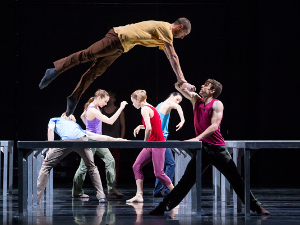Given that the majority of the 64 undergraduate musicians on stage were not music majors, the closing concert of the Wake Forest University Orchestra was remarkable, as much for the quality of the music making as for the choice of repertory. The orchestra was conducted by faculty member Dr. David Hagy, who pulled no punches, galloping full speed toward his musical objectives as if this were an experienced professional orchestra. Although somewhat understaffed in the string sections, the vigor and enthusiasm of the ensemble as a whole amply compensated for any shortage in number, especially in the louder passages.
University and college orchestras are as diverse as the institutions which sponsor them. Sometimes they are town-gown organizations (e.g. Duke University or University of Iowa, where I grew up). Sometimes, as in the case of Wake Forest University or the UNC School of the Arts, they are exclusively student, with or without graduate students. In each case the available pool of musicians must be balanced with the musical ambitions and ideals of the faculty. Small schools will be happy with a chamber orchestra; Indiana University will have half a dozen symphonic ensembles.
In celebration of the hundredth anniversary of his birth, the first half of this program presented two works by American composer Samuel Barber: the Adagio for Strings and excerpts from the ballet, Medea. Now an American icon, Barber clung to his love of melody, as explained the witty Maestro Hagy, while other composers were experimenting with color, rhythmic complexity or aleatoric (improvisatory) choices.
Certainly his best known work, the Adagio, as originally composed, was part of Barber’s First String Quartet, written in 1936 during a prolonged sojourn in Rome. In the full string orchestra version, it was given its premier performance under the baton of Arturo Toscanini in 1938, and has remained popular since. It is here that one might have wished for double or triple the number of string players. Although the opening and closing pianissimi were admirable, the emotional climax fell short of expectations, mostly due to lack of players.
The addition of a large wind and percussion contingency for the second Barber work on the program, the Meditation and Dance of Vengeance from the ballet Medea, made for a brilliant and colorful performance. From the ominous rumbling of the bass drum at the beginning, felt rather than heard, to the excellent solos in the flute, oboe, horn and a lovely duet of concertmaster and principal viola, to the culmination in a spectacular ending, this performance “rocked.”
The second half of the concert brought us the Pictures at an Exhibition of the iconoclast Russian composer, Modeste Mussorgsky, a work originally for piano but most often played in the orchestration of Maurice Ravel. Prodigiously difficult as a solo piano work, this popular orchestral version has become required reading for any student of composition or orchestration, so skillful and colorful is the instrumentation by Ravel.
There were many well-played solos in this episodic suite: throughout, the brass played their Promenades well. The saxophone solo in “Castello Vecchio” (Elizabeth Hartley) was lovely, with a rapid expressive vibrato recalling the flute of legendary Marcel Moise; the euphonium (Robert Rose) played the lumbering “Bidło” (Polish ox-cart) to its awkward perfection. Maestro Hagy wisely chose a sober tempo for the “Ballet of the Chicks in Their Shells,” allowing the precarious oboe solo to peck through exquisitely (Christine Miller). I had a minor quibble with the tempo of “Samuel Goldenberg and Schmuÿle,” finding it too fast to adequately develop the schnorrer characteristics of Schmuÿle, but the trumpet playing was nonetheless splendid.
The best playing of the evening came in the two last movements, “Baba Yaga” and the “Great Gate of Kiev.” And except for some intonation problems in the Orthodox plainsong sections, the orchestra outdid itself, with balanced chords, brilliant scales and power galore from the brass.
My skepticism prior to the concert about the appropriateness of such a difficult and exposed program was won over by the realization that the students had undergone a transformative experience. The audience was equally impressed by what it had heard and expressed itself in a vociferous standing ovation.











